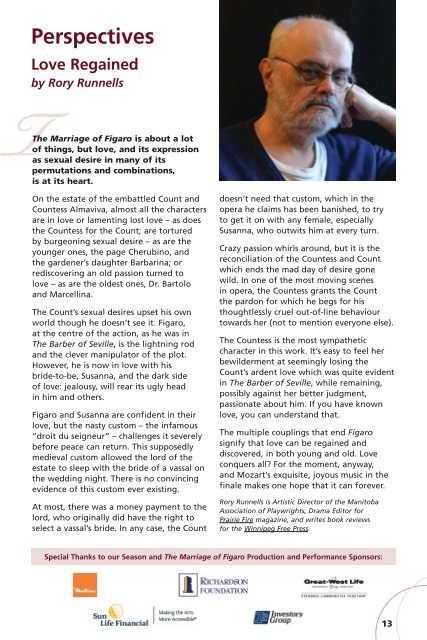Raquelle
URpxR
URpxR
Create successful ePaper yourself
Turn your PDF publications into a flip-book with our unique Google optimized e-Paper software.
Perspectives<br />
Love Regained<br />
by Rory Runnells<br />
The Marriage of Figaro is about a lot<br />
of things, but love, and its expression<br />
as sexual desire in many of its<br />
permutations and combinations,<br />
is at its heart.<br />
On the estate of the embattled Count and<br />
Countess Almaviva, almost all the characters<br />
are in love or lamenting lost love – as does<br />
the Countess for the Count; are tortured<br />
by burgeoning sexual desire – as are the<br />
younger ones, the page Cherubino, and<br />
the gardener’s daughter Barbarina; or<br />
rediscovering an old passion turned to<br />
love – as are the oldest ones, Dr. Bartolo<br />
and Marcellina.<br />
The Count’s sexual desires upset his own<br />
world though he doesn’t see it. Figaro,<br />
at the centre of the action, as he was in<br />
The Barber of Seville, is the lightning rod<br />
and the clever manipulator of the plot.<br />
However, he is now in love with his<br />
bride-to-be, Susanna, and the dark side<br />
of love: jealousy, will rear its ugly head<br />
in him and others.<br />
Figaro and Susanna are confident in their<br />
love, but the nasty custom – the infamous<br />
“droit du seigneur” – challenges it severely<br />
before peace can return. This supposedly<br />
medieval custom allowed the lord of the<br />
estate to sleep with the bride of a vassal on<br />
the wedding night. There is no convincing<br />
evidence of this custom ever existing.<br />
At most, there was a money payment to the<br />
lord, who originally did have the right to<br />
select a vassal’s bride. In any case, the Count<br />
doesn’t need that custom, which in the<br />
opera he claims has been banished, to try<br />
to get it on with any female, especially<br />
Susanna, who outwits him at every turn.<br />
Crazy passion whirls around, but it is the<br />
reconciliation of the Countess and Count<br />
which ends the mad day of desire gone<br />
wild. In one of the most moving scenes<br />
in opera, the Countess grants the Count<br />
the pardon for which he begs for his<br />
thoughtlessly cruel out-of-line behaviour<br />
towards her (not to mention everyone else).<br />
The Countess is the most sympathetic<br />
character in this work. It’s easy to feel her<br />
bewilderment at seemingly losing the<br />
Count’s ardent love which was quite evident<br />
in The Barber of Seville, while remaining,<br />
possibly against her better judgment,<br />
passionate about him. If you have known<br />
love, you can understand that.<br />
The multiple couplings that end Figaro<br />
signify that love can be regained and<br />
discovered, in both young and old. Love<br />
conquers all? For the moment, anyway,<br />
and Mozart’s exquisite, joyous music in the<br />
finale makes one hope that it can forever.<br />
Rory Runnells is Artistic Director of the Manitoba<br />
Association of Playwrights, Drama Editor for<br />
Prairie Fire magazine, and writes book reviews<br />
for the Winnipeg Free Press.<br />
Special Thanks to our Season and The Marriage of Figaro Production and Performance Sponsors:<br />
13


